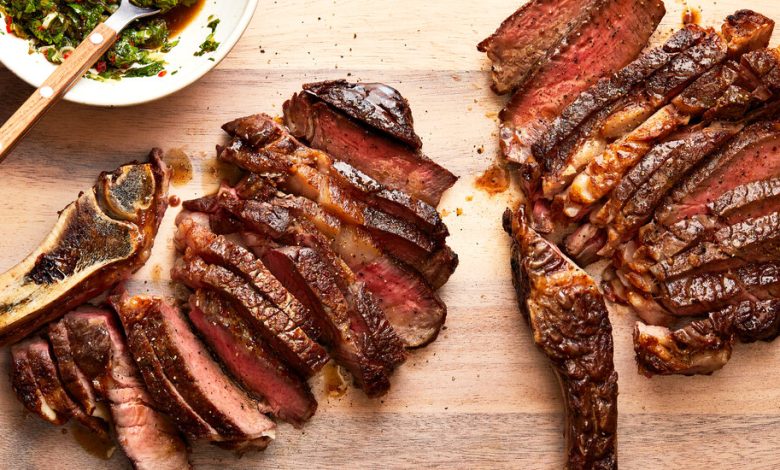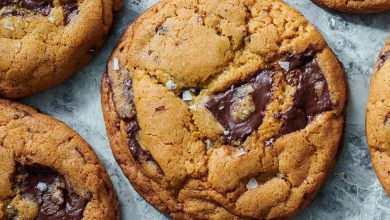The Best Way to Cook Steak for Holiday Parties

There’s an undeniable urge to roar — or at least growl — when setting a thick steak into a ripping hot pan. Hearing the hard hiss of the sizzling fat is satisfaction enough, but then the smell of charred meat follows fast, and it’s pure pleasure from there.
Recipe: Seared Bone-In Rib-Eye Steaks
And no cut delivers a bigger cooking thrill — or better eating — than bone-in rib-eyes with their generous marbling and primal richness. Butchered from the same part of the cow as prime rib, the steaks have the tenderness of the roast but with a salty crust in every bite. I love serving them for parties, especially around the holidays, and have had to figure out a technique that works when hosting guests.
Searing is intense cooking and, unlike grilling outdoors, best done when alone. Holistically, it’s a solitary meditation between you and the meat. Practically, it’s not great having people crowd around the stove when you need to focus and when smoke and hot fat spews and shoots out of the pan. That’s why I prefer to reverse-reverse-sear bone-in steaks.
And no, that actually does not equal simply searing steak. Usually, that involves steadily flipping meat only on the stovetop or starting on the stove then transferring to a blazing-hot oven to finish cooking through quickly. Reverse-searing calls for first bringing meat to its desired doneness in a low oven, then searing at the very end. All of those methods, reverse searing in particular, turn out evenly medium-rare centers and charred crusts, but require you to be in the kitchen instead of with your guests. Also, they can send up a greasy, gray haze that sets off blaring fire alarms during your dinner party.
To nail the perfect rib-eye without smoking out your friends or ruining such a splurge, reverse-reverse sear by developing a crust first on the stovetop, then letting the meat become tender in a low oven. This turns out a beautifully browned crust and evenly rosy center without a khaki ring of over-doneness — and gives you time to wash up and pour drinks for guests. The fumes will clear before it’s time to eat, but the aroma that makes everyone drool will linger.
Angie Mar, the chef and owner of Le B. in Manhattan, is known for her meat dishes and uses a similar approach. “You get a great steak that way,” she said. “The one big caveat to this whole thing is that we temper our meats, and we let them rest for a very long time.” Bringing the meat to room temperature before cooking is key to avoiding a cold middle that’s as red and jiggly as jelly, and letting it sit after it comes out ensures it stays juicy.
At her restaurant, she has the luxury of a tall stack of skillets and a commercial hood, so each steak goes into the oven in its pan. At home, you can do the same if you’re cooking only one steak. When preparing multiple slabs, sear them one at a time, then set them on a heated half-sheet pan all at once so they’re done all at the same time.
To test for doneness, Ms. Mar uses a wire-thin metal cake tester. She slides it in through the side of the meat to the center, then pulls it out and presses it against the sensitive skin of an inner wrist or upper lip. If it feels warm bordering on hot, “that’s how I know I’ve got a perfect medium-rare.” If you want more certainty, use a good instant-read meat thermometer and pull out the meat at the lower end of the range (115 degrees) to keep the steaks warm for a longer stretch before serving. The internal temperature of the meat will rise as it rests.
Because the meat holds so much flavor, it can be served unadorned, but a simple herb sauce heightens its earthy depth. Scallions and chile lose their edge when sizzled in the skillet’s fat, then gain tanginess with a splash of vinegar that helps balance the steak’s richness. That combination of juicy meat and freshness is party eating at its best — and having it all done before guests arrive is the best way to entertain.
Follow New York Times Cooking on Instagram, Facebook, YouTube, TikTok and Pinterest. Get regular updates from New York Times Cooking, with recipe suggestions, cooking tips and shopping advice.




